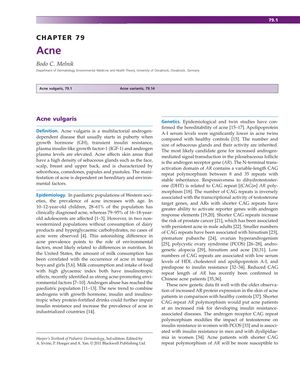Acne
May 2011
in “
Harper's Textbook of Pediatric Dermatology
”
acne vulgaris androgens insulin-like growth factors sebaceous gland activity Propionibacterium acnes inflammation CAG repeats androgen receptor gene non-inflammatory lesions inflammatory lesions scarring milk consumption high glycaemic foods high protein diet low glycemic load diet neonatal acne infantile acne endocrine abnormalities acne fulminans genetic syndromes chloracne drug-induced eruptions acne hormones bacteria diet scars milk sugar protein diet baby acne hormonal acne severe acne genetic acne chemical acne medication-induced acne

TLDR Acne is a common skin condition linked to diet, hormones, and genetics, and early treatment can prevent scarring.
The document from May 24, 2011, provides a comprehensive overview of acne vulgaris, a multifactorial androgen-dependent disease with a high prevalence in Western societies, affecting 79-95% of 16-18-year-olds. It is absent in non-westernized populations that do not consume dairy products and hyperglycaemic carbohydrates. The pathogenesis of acne involves abnormal follicular differentiation, increased sebaceous gland activity, colonization by Propionibacterium acnes, and inflammation. Androgens and insulin-like growth factors play a significant role in sebaceous lipogenesis, with genetic factors such as the number of CAG repeats in the androgen receptor gene influencing the condition. The document also discusses the clinical manifestations of acne, including non-inflammatory and inflammatory lesions, and outlines treatment strategies based on severity, emphasizing the importance of early and prolonged treatment to prevent scarring. Additionally, it touches on the role of diet, particularly milk consumption and high glycaemic foods, in promoting acne and the potential benefits of a high protein, low glycemic load diet. It also covers various forms of acne and their treatments, including neonatal acne, infantile acne, acne in endocrine abnormalities, acne fulminans, and genetic syndromes associated with acne, as well as acneiform eruptions like chloracne and drug-induced eruptions.












